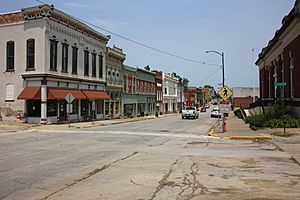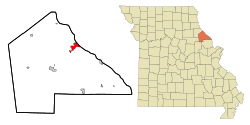Louisiana, Missouri facts for kids
Quick facts for kids
Louisiana, Missouri
|
|
|---|---|

Louisiana, Missouri in June 2018
|
|

Location of Louisiana, Missouri
|
|
| Country | United States |
| State | Missouri |
| County | Pike |
| Area | |
| • Total | 3.42 sq mi (8.86 km2) |
| • Land | 3.13 sq mi (8.12 km2) |
| • Water | 0.29 sq mi (0.75 km2) |
| Elevation | 492 ft (150 m) |
| Population
(2020)
|
|
| • Total | 3,199 |
| • Density | 1,020.74/sq mi (394.11/km2) |
| Time zone | UTC-6 (Central (CST)) |
| • Summer (DST) | UTC-5 (CDT) |
| ZIP code |
63353
|
| Area code(s) | 573 |
| FIPS code | 29-44174 |
| GNIS feature ID | 2395770 |
Louisiana is a city in Pike County, Missouri, United States. It's located in the northeast part of Missouri, right on the Mississippi River. The city is south of Hannibal. In 2010, about 3,364 people lived here.
Louisiana is where State Route 79 and US 54 meet. Route 79 follows the Mississippi River for much of its way. US 54 comes into Louisiana from Illinois over the Champ Clark Bridge. This bridge is named after Champ Clark, who was a former US Speaker of the House from nearby Bowling Green.
Contents
History of Louisiana, Missouri
The city of Louisiana was started in 1816 by John Walter Basye. He named it after his daughter, Louisiana Basye. Other early settlers, Samuel Caldwell and Joel Shaw, bought land from Basye in 1818. These first properties were mostly along the river. Many people living in Louisiana today can trace their families back to these early settlers.
Louisiana became an important place for shipping goods on the Mississippi River. This brought a lot of wealth to the town. Because of this, many large and beautiful homes were built before the American Civil War. Many of these old homes are still standing. The Georgia Street Historic District in downtown Louisiana, along with many of these homes, are listed on the National Register of Historic Places. This means they are important historical sites. The Missouri Department of Natural Resources says Louisiana has "the most intact Victorian Streetscape in the state of Missouri." This means its old streets look very much like they did in the Victorian era.
Louisiana is part of something called the "50 Miles of Art" corridor. This connects Louisiana, Clarksville, and Hannibal through their history and Route 79. Many artists and craftspeople live in these towns. Louisiana also hosts a fun event each year called the Louisiana Country Colorfest.
In 1946, a special plant was built in Louisiana. Scientists worked there to create liquid fuels. Some of these scientists came from Germany to help with the research.
Today, Louisiana is looking towards "green energy." An old plant that used to make ammonia has been changed to study and produce new types of fuels. The city is also home to the main office of Lens.com, an online contact lens company.
Louisiana Country Colorfest
The Louisiana Country Colorfest is the biggest festival in Pike County. It started in 1984 and happens every year on the third weekend in October. More than 8,000 people come to enjoy this event.
Historic Places in Louisiana
Besides the Georgia Street Historic District, many other buildings in Louisiana are listed on the National Register of Historic Places. These include:
- Charles Bacon House
- Capt. George and Attella Barnard House
- Bethel Chapel AME Church
- City Market
- Goodman-Stark House
- Louisiana Chicago & Alton Railroad Depot
- Louisiana Public Library
- North Third Street Historic District
- Pike County Hospital
- Gov. Lloyd Crow Stark House and Carriage House
Geography of Louisiana
Louisiana is located in the northern part of Pike County, right on the Mississippi River. You can reach the city using U.S. Route 54 and Missouri Route 79. Bowling Green is about ten miles southwest on Route 54. The town of Pike, Illinois is just across the river to the northeast. Clarksville is about nine miles southeast along Route 79.
The city covers a total area of about 3.42 square miles (8.86 square kilometers). Most of this area, about 3.13 square miles (8.12 square kilometers), is land. The rest, about 0.29 square miles (0.75 square kilometers), is water.
Population of Louisiana
| Historical population | |||
|---|---|---|---|
| Census | Pop. | %± | |
| 1850 | 912 | — | |
| 1860 | 2,436 | 167.1% | |
| 1870 | 3,639 | 49.4% | |
| 1880 | 4,325 | 18.9% | |
| 1890 | 5,090 | 17.7% | |
| 1900 | 5,131 | 0.8% | |
| 1910 | 4,454 | −13.2% | |
| 1920 | 4,060 | −8.8% | |
| 1930 | 3,549 | −12.6% | |
| 1940 | 4,669 | 31.6% | |
| 1950 | 4,389 | −6.0% | |
| 1960 | 4,286 | −2.3% | |
| 1970 | 4,533 | 5.8% | |
| 1980 | 4,261 | −6.0% | |
| 1990 | 3,967 | −6.9% | |
| 2000 | 3,863 | −2.6% | |
| 2010 | 3,364 | −12.9% | |
| 2020 | 3,199 | −4.9% | |
| U.S. Decennial Census | |||
Quick Facts from the 2010 Census
In 2010, Louisiana had a population of 3,364 people. The city had 1,411 households. The average age of people in the city was about 41 years old.
Education in Louisiana
Public schools in Louisiana are managed by the Louisiana R-II School District. The city also has a public library where you can borrow books, called the Louisiana Public Library.
Transportation in Louisiana
While Louisiana does not have its own local bus service, you can find intercity bus service nearby. Burlington Trailways provides bus service in Bowling Green, which is close to Louisiana.
Notable People from Louisiana
Many interesting people have connections to Louisiana, Missouri. Here are a few:
- James E. Allen (1894–1964), an artist.
- Ratliff Boon (1781–1844), a politician.
- George Samuel Clason (1874–1957), an author who wrote The Richest Man in Babylon.
- Edwin Evers (born 1974), a professional fisherman.
- Claude Gillingwater (1870–1939), an actor.
- Emily Harrison (born 1977), an actress.
- Eddie South (1904–1962), a famous jazz violinist.
- Lloyd C. Stark (1886–1982), who became the 39th Governor of Missouri.
See also
 In Spanish: Louisiana (Misuri) para niños
In Spanish: Louisiana (Misuri) para niños

